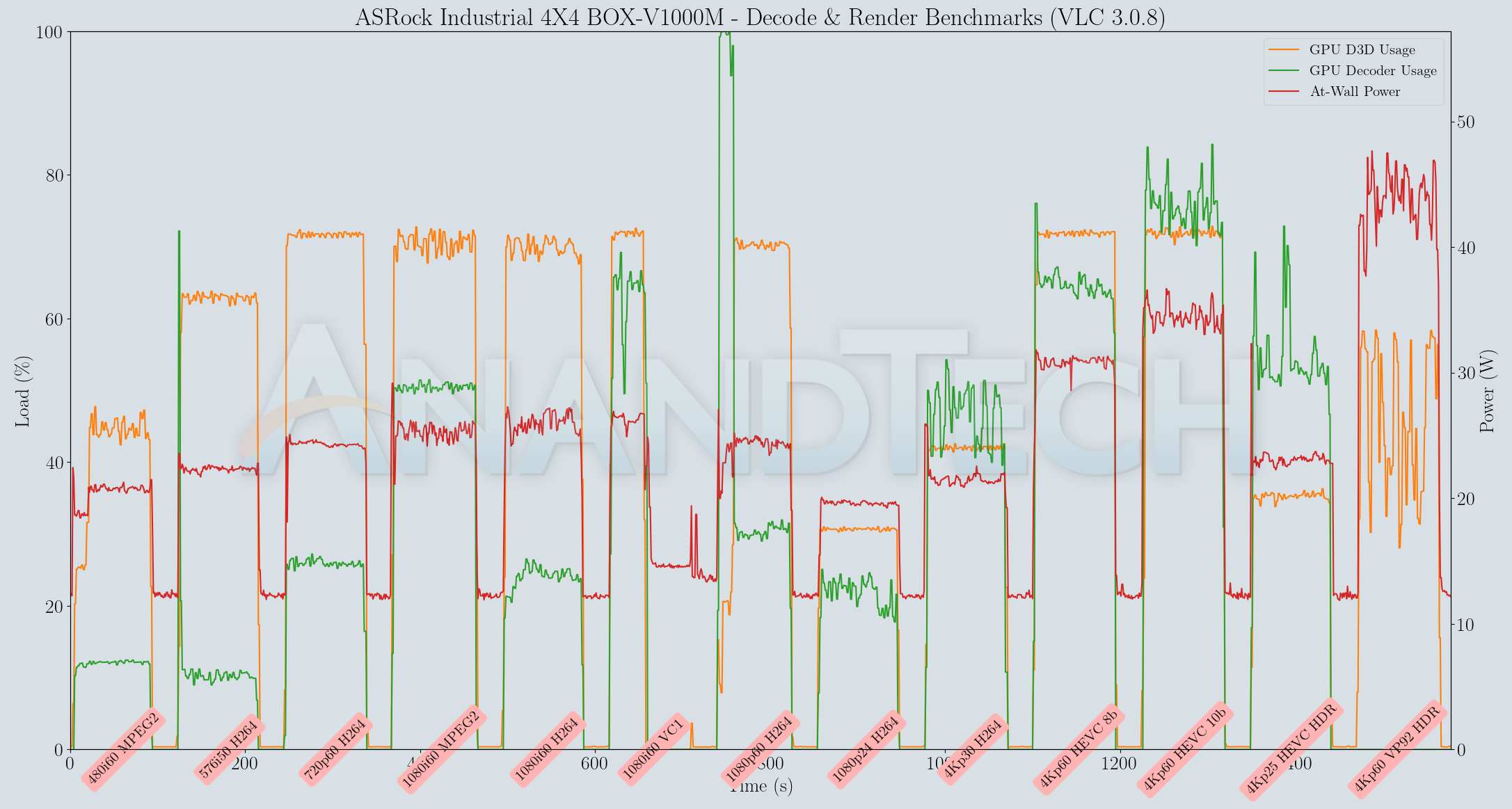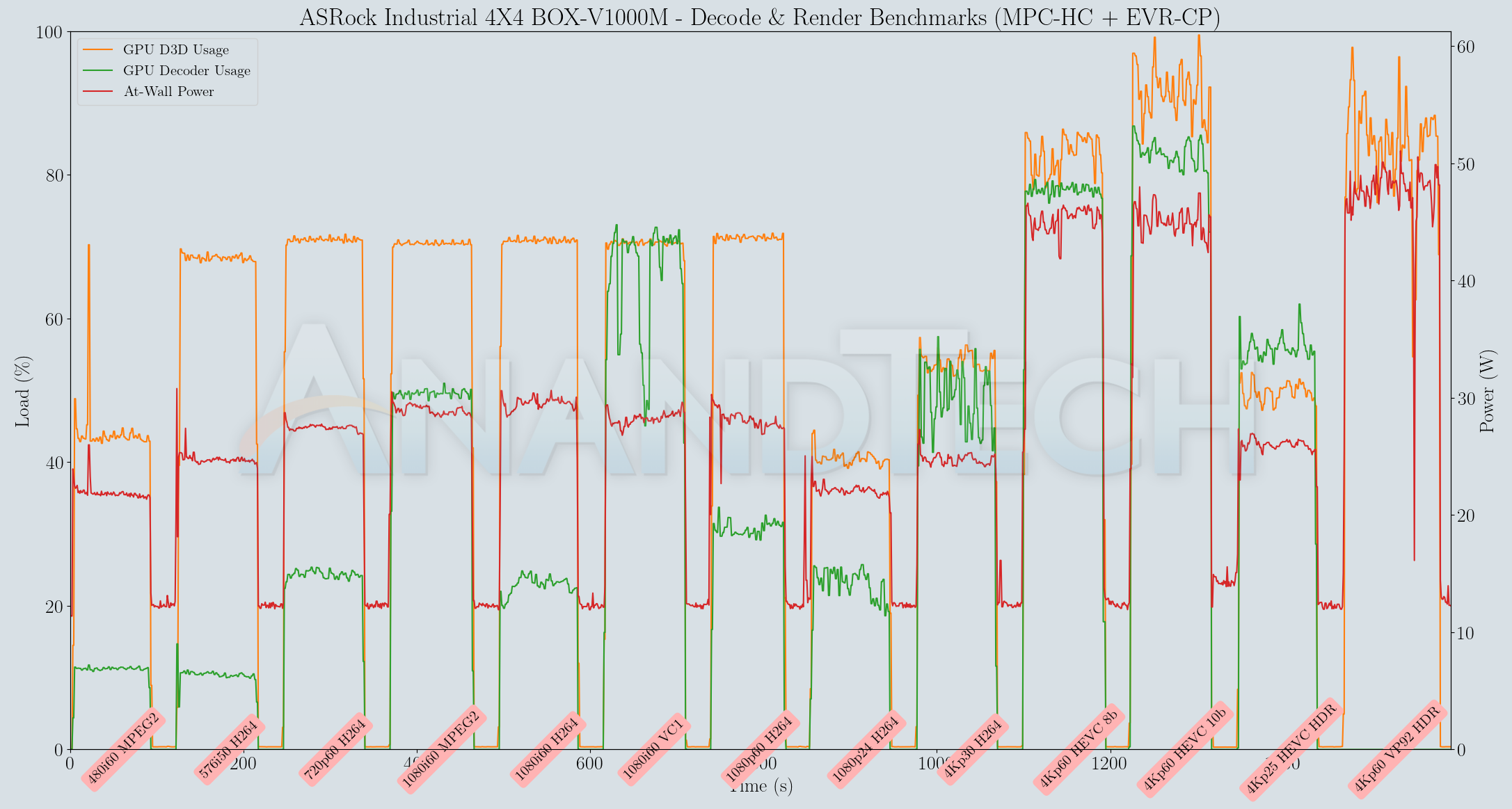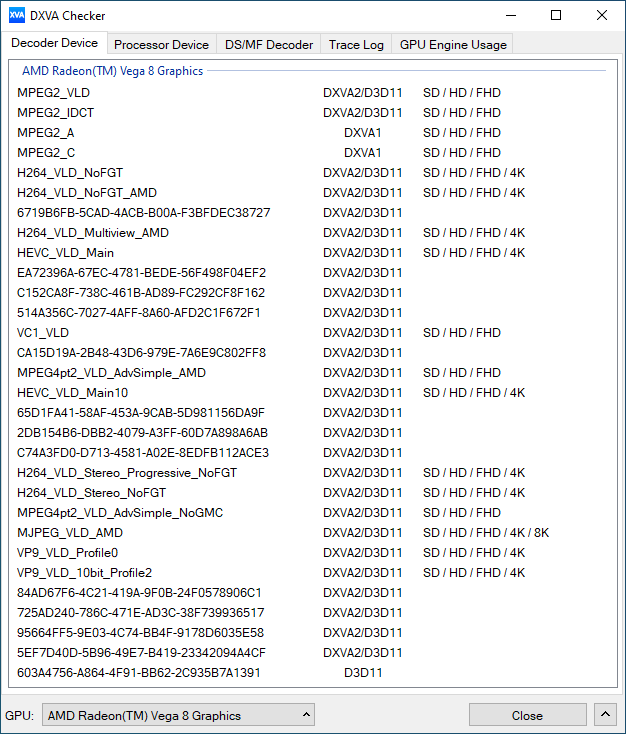ASRock Industrial 4X4 BOX-V1000M Ryzen Mini-PC Review: Finding Zen In The Small Things
by Ganesh T S on September 28, 2020 8:00 AM EST- Posted in
- Systems
- AMD
- NUC
- UCFF
- Ryzen
- Ryzen Embedded
- ASRock Industrial
HTPC Credentials - Local Media Playback and Video Processing
Evaluation of local media playback and video processing is done by playing back files encompassing a range of relevant codecs, containers, resolutions, and frame rates. A note of the efficiency is also made by tracking GPU usage and power consumption of the system at the wall. Users have their own preference for the playback software / decoder / renderer, and our aim is to have numbers representative of commonly encountered scenarios. Towards this, we played back the test streams using the following combinations:
- MPC-HC x64 1.8.5 + LAV Video Decoder (DXVA2 Native) + Enhanced Video Renderer - Custom Presenter (EVR-CP)
- MPC-HC x64 1.8.5 + LAV Video Decoder (D3D11) + madVR 0.92.17 (DXVA-Focused)
- MPC-HC x64 1.8.5 + LAV Video Decoder (D3D11) + madVR 0.92.17 (Lanczos-Focused)
- VLC 3.0.8
- Kodi 18.6
The thirteen test streams (each of 90s duration) were played back from the local disk with an interval of 30 seconds in-between. Various metrics including GPU usage and at-wall power consumption were recorded during the course of this playback. Prior to looking at the metrics, a quick summary of the decoding capabilities of the Vega 8 integrated GPU is useful to have for context.
Accelerated decoding support up to 4K resolution is available for AVC, HEVC (8b and 10b), MPEG-4, and VP9 (8b and 10b). MJPEG decoding support exists for up to 8K resolution and VC1 for up to 1080p.
All our playback tests were done with the desktop HDR setting turned on. It is possible for certain system configurations to have madVR automatically turn on/off the HDR capabilities prior to the playback of a HDR video, but, we didn't take advantage of that in our testing.
VLC and Kodi
VLC is the playback software of choice for the average PC user who doesn't need a ten-foot UI. Its install-and-play simplicity has made it extremely popular. Over the years, the software has gained the ability to take advantage of various hardware acceleration options. Kodi, on the other hand, has a ten-foot UI making it the perfect open-source software for dedicated HTPCs. Support for add-ons make it very extensible and capable of customization. We played back our test files using the default VLC and Kodi configurations, and recorded the following metrics.
| Video Playback Efficiency - VLC and Kodi | |||

The graphs above indicate that the decoding of the interlaced VC-1 stream is finicky with both VLC and Kodi. Another interesting aspect is that VLC doesn't use accelerated decoding for the VP9 Profile 2 stream, while Kodi does. Other than VC-1 playback (which was fine with the official Video player app in Windows), the decoder testing process was smooth. At-Wall power consumption for the system ranged from 20W-45W depending on the stream and the player.
MPC-HC
MPC-HC offers an easy way to test out different combinations of decoders and renderers. The first configuration we evaluated is the default post-install scenario, with only the in-built LAV Video Decoder forced to DXVA2 Native mode. Two additional passes were done with different madVR configurations. In the first one (DXVA-focused), we configured madVR to make use of the DXVA-accelerated video processing capabilities as much as possible. In the second (Lanczos-focused), the image scaling algorithms were set to 'Lanczos 3-tap, with anti-ringing checked'. Chroma upscaling was configured to be 'BiCubic 75 with anti-ringing checked' in both cases. The metrics collected during the playback of the test files using the above three configurations are presented below.
| Video Playback Efficiency - MPC-HC with EVR-CP and madVR | |||

The 4Kp60 streams were a hit or a miss with the different combinations tested above. VC-1 playback was sensitive to madVR settings (working well with DXVA scaling, but failing with the custom configuration). Other 1080p and lower resolution streams had no trouble in playback even with the upscaling to 4K in the picture. These are to be expected, given that madVR is meant to mostly be used with discrete GPUs.











37 Comments
View All Comments
hallstein - Monday, September 28, 2020 - link
I just want to say how much I appreciate the title of this article. Great work.deil - Monday, September 28, 2020 - link
I will also endorse. Pure perfection. Try doing it with 1185g7, even intel did not try.AMDSuperFan - Monday, September 28, 2020 - link
This does not look like a good product for AMD fans. I am very concerned. Where are the products that can compete against someone? $560 and it doesn't even have a battery?DiHydro - Monday, September 28, 2020 - link
This is not a consumer product. it is for industrial applications were longevity and support are more important than initial price.PeterEvans - Monday, September 28, 2020 - link
Did you have the idea that industrial applications should cost more for longevity? I actuality it is the exact opposite.Spunjji - Tuesday, September 29, 2020 - link
Re: the only factual part of your post, it's only about $100 more than the near-useless Atom-based "June Canyon" NUC, $40 more than the Coffee Lake DeskMini and nearly $200 less than the Comet Lake "Frost Canyon" NUC - and if you need any GPU power there's no contest between them. But sure, please continue to make disingenuous shitposts in order to feed the thrashing mess of worms inside your brain.Ryan Smith - Tuesday, September 29, 2020 - link
Thanks! We've reviewed a lot of NUCs over the years, including AMD ones. So it's an interesting challenge to try to come up with unique titles.tygrus - Monday, September 28, 2020 - link
It's a pity the tech is 2 yrs old (Zen 14nm).What about:
4700G
4900HS
4800U
AMD moving slowly to update all product categories but OEM'S are moving even slower. Who or what are holding them back? Does Intel incentives & previous market dominance delay OEM's releasing AMD products or does AMD have some blame?
5080 - Monday, September 28, 2020 - link
They do offer this unit with a 4800U, see my comment below.DiHydro - Monday, September 28, 2020 - link
This is an industrial mini-PC. Usually used for visual inspection systems, or running GUI controls for machines. They wouldn't need a whole lot of processing power, and would prefer a fully vetted and reliable system (shame about the GPU drivers). That being said, the Ryzen 4000 series is much more attractive for home and office use in the NUC space.